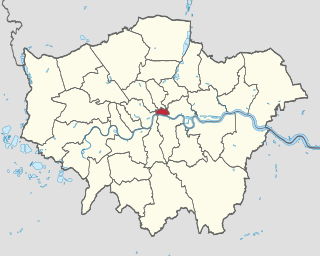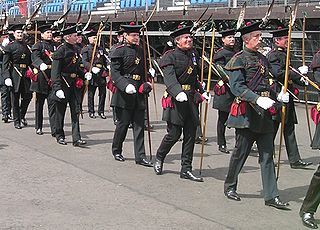
Holyrood Abbey is a ruined abbey of the Canons Regular in Edinburgh, Scotland. The abbey was founded in 1128 by David I of Scotland. During the 15th century, the abbey guesthouse was developed into a royal residence, and after the Scottish Reformation the Palace of Holyroodhouse was expanded further. The abbey church was used as a parish church until the 17th century, and has been ruined since the 18th century. The remaining walls of the abbey lie adjacent to the palace, at the eastern end of Edinburgh's Royal Mile. The site of the abbey is protected as a scheduled monument.
A constable is a person holding a particular office, most commonly in criminal law enforcement. The office of constable can vary significantly in different jurisdictions. A constable is commonly the rank of an officer within the police. Other people may be granted powers of a constable without holding this title.

The City of London Police is the territorial police force responsible for law enforcement within the City of London, England, including the Middle and Inner Temples. The force responsible for law enforcement within the remainder of the London region, outside the city, is the much larger Metropolitan Police, a separate organisation. The City of London, which is now primarily a financial business district with a small resident population but a large commuting workforce, is the historic core of London, and has an administrative history distinct from that of the rest of the metropolis, of which its separate police force is one manifestation.

The Royal Parks Constabulary (RPC) was the police force formerly responsible for the Royal Parks in London and a number of other locations in Greater London, England and Edinburgh, Scotland. Unlike most other police forces operating in England and Wales, the Royal Parks Constabulary did not report to the Home Office, but instead to the Department for Culture, Media and Sport, who provided funding for it through the Royal Parks Agency.
Police ranks are a system of hierarchical relationships in police organisations. The rank system defines authority and responsibility in a police organisation, and affects the culture within the police force. Usually, uniforms denote the bearer's rank by particular insignia affixed to the uniforms.

The Royal Company of Archers, The King's Bodyguard for Scotland, is a ceremonial unit that serves as the Sovereign's bodyguard in Scotland—a role it has performed since 1822 during the reign of King George IV when the company provided a personal bodyguard to the King on his visit to Scotland. It is currently known as the King's Bodyguard for Scotland or, more often and colloquially, The Royal Company. It is located in Edinburgh, the capital city of Scotland. The Royal Company of Archers has a long history in Scotland as a body that celebrated both the recreation and talent of local archers. As a body established by the Monarch, the company has a long history of unique prizes, influential supporters, and ceremonial roles. It has an associated charity, the Royal Company of Archers Charitable Trust, dedicated to helping disadvantaged individuals with their health and wellbeing in Scotland.

Sovereign's Bodyguard is the name given to three ceremonial units in the United Kingdom who are tasked with guarding the Sovereign. These units are:

George IV's visit to Scotland in 1822 was the first visit of a reigning monarch to Scotland in nearly two centuries, the last being by Charles II for his Scottish coronation in 1651. Government ministers had pressed the King to bring forward a proposed visit to Scotland, to divert him from diplomatic intrigue at the Congress of Verona.

The City of Glasgow Police or Glasgow City Police was the police covering the city and royal burgh of Glasgow, from 1800 to 1893, and the county of city of Glasgow, from 1893 to 1975. In the 17th century, Scottish cities used to hire watchmen to guard the streets at night, augmenting a force of unpaid citizen constables. On 30 June 1800 the authorities of Glasgow successfully petitioned the British Government to pass the Glasgow Police Act establishing the City of Glasgow Police. It served Glasgow from 1800 to 1975, when it was amalgamated into Strathclyde Police.
The High Constables of Holyroodhouse are a small corps of ceremonial bodyguards at the Sovereign's official residence in the Scottish capital, Edinburgh. Created in the early sixteenth century to protect the Monarch in residence at Holyrood, as well as to guard the Palace and Abbey, and enforce law and order within the precincts of the Palace and the Holyrood Abbey Sanctuary.

The Kirk of the Canongate, or Canongate Kirk, serves the Parish of Canongate in Edinburgh's Old Town, in Scotland. It is a congregation of the Church of Scotland. The parish includes the Palace of Holyroodhouse and the Scottish Parliament. It is also the parish church of Edinburgh Castle, even though the castle is detached from the rest of the parish. The wedding of Zara Phillips, the Queen's granddaughter, and former England rugby captain Mike Tindall took place at the church on 30 July 2011. The late Queen Elizabeth II used to attend services in the church on some of her frequent visits to Edinburgh.

The Right Honourable Lord Provost of Edinburgh is elected by and is the convener of the City of Edinburgh Council and serves not only as the chair of that body, but as a figurehead for the entire city, ex officio the Lord-Lieutenant of Edinburgh and honorarily the Admiral of the Firth of Forth. It is the equivalent in many ways to the institution of Mayor that exists in many other countries.
The High Court of Constabulary was a court in Scotland presided over by the Lord High Constable of Scotland and other judges known as Constables-depute. The court had exclusive jurisdiction over crimes of rioting, disorder, bloodshed, and murder that took place within 4 miles (6.4 km) of the Monarch of Scotland, Privy Council of Scotland, or the Parliament of Scotland. It was established in the 13th century, and its de jure jurisdiction continued until at least the 19th century. From the 16th century the Constables-depute appear to have been the Lord Provosts, bailies, and Sheriffs of Edinburgh. Following the Treaty of Union of 1707, the Court had jurisdiction when the Monarch of Great Britain, and later the Monarch of the United Kingdom, was resident at the Palace of Holyrood House.
Police uniforms and equipment in the United Kingdom vary enormously per force or service, and different uniforms and equipment is used for different situations. Both what is worn and what is carried have varied considerably from the inception of the earliest recognisable mainstream police services in the early 19th century. As various laws in the mid-19th century standardised policing in the United Kingdom, so too were uniforms and equipment. From a variety of home grown uniforms, bicycles, swords and pistols the British police force evolved in look and equipment through the long coats and top hat, to the recognisable modern uniform of a white shirt, black tie, reflective jackets, body armour, and the battenburg-marked vehicles, to the present-day Airwave Solutions radios, electric vehicles and tasers.

The history of law enforcement in the United Kingdom charts the development of law enforcement in the United Kingdom and its predecessor states. It spans the period from the Middle Ages, through to the development of the first modern police force in the world in the nineteenth century, and the subsequent modernisation of policing in the twentieth and twenty-first centuries.

The Palace of Holyroodhouse, commonly referred to as Holyrood Palace or Holyroodhouse, is the official residence of the British monarch in Scotland. Located at the bottom of the Royal Mile in Edinburgh, at the opposite end to Edinburgh Castle, Holyroodhouse has served as the principal royal residence in Scotland since the 16th century, and is a setting for state occasions and official entertaining.

Margaret Stuart was the second daughter of King James VI of Scotland and Anne of Denmark. Sometime in March 1600, Margaret died of an unknown illness and she was buried in Holyrood Abbey. Three years later, her father ascended the throne of England.
High Constabulary of the Port of Leith was founded in the late 17th century, to deal with safety in the royal port and behaviour in streets of the port of Leith near Edinburgh, Scotland. It continues to this day as a ceremonial port police organisation.

The Hampstead Heath Constabulary (HHC) is the organisation that patrols Hampstead Heath, London, which is administered by the City of London Corporation.













